Abstract
Background: Accurate delivery of radiotherapy is a paramount component of providing safe oncological care. Margins are applied when planning radiotherapy to account for subclinical tumour spread, physiological movement and setup error. Setup error is unique to each radiotherapy institution and should be calculated for each organ site to ensure safe delivery of treatment.
Aim: The aim of this study is to calculate the random and systematic setup error for a cohort of patients with intracranial tumours treated with 3D Conformal Radiotherapy.
Setting: The Department of Radiation Oncology, Groote Schuur Hospital, South Africa.
Method: After obtaining above mentioned data, the ideal Clinical Target Volume (CTV)-Planning Target Volume (PTV) expansion margin was calculated using published CTV-PTV expansion margin recipes. The electronic portal images of 20 patients who met the inclusion criteria were compared to their digitally reconstructed radiograph. The setup error for each patient was measured after which the random (σ) and systematic (Σ) setup error for the study group could be calculated. With both these values known, the CTV-PTV expansion margin could be determined.
Results: The largest error was in the superior/inferior direction (87.7% < 3mm; 6.1% > 5mm), followed by the medial/lateral direction (76.2% < 3 mm; 0 > 5 mm) and least in the anterior/posterior direction (91.6% < 3 mm; 0 > 5 mm). The random and systematic errors in all three directions for this patient cohort were less than 2 mm, conforming to acceptable standards of delivering safe radiotherapy. Using Stroom’s margin recipe (2Σ + 0.7σ) a CTV-PTV expansion margin of 5 mm can safely be applied for this patient cohort.
Conclusion: When treating patients with intracranial tumours at Groote Schuur Hospital the CTV-PTV expansion margin can safely be reduced from 1 cm to 5 mm.
Keywords: Setup margin; random error; systematic error; intracranial tumours; CTV-PTV expansion margin.
Introduction
Accuracy of radiation delivery in radiotherapy is critical to ensure adequate coverage of a tumour and minimisation of normal tissue dose. It is important to establish uncertainties in dose distribution so that suitable treatment margins can be used for optimal therapy.
The International Commission on Radiation Units and Measurements (ICRU) report Number 50 introduced the concept of a gross tumour volume (GTV), a clinical target volume (CTV) and a planning target volume (PTV)1 in radiotherapy. The GTV is classified as the gross demonstrable extent and location of the malignant growth.1 The CTV is a tissue volume that contains a demonstrable GTV or subclinical malignant disease that must be eliminated. The CTV is a clinical-anatomical concept and can be described as including structures with clinically suspected but unproved involvement.1,2 The GTV almost always corresponds to those parts of the malignant growth where the tumour cell density is the highest, hence the importance of delivering adequate dose to the whole GTV.2 The PTV is a geometrical concept used for treatment planning and it is defined to select appropriate beam sizes and beam arrangements to ensure that the prescribed dose is actually delivered to the CTV.1,2
Errors in radiotherapy can either be random or systematic. Systematic errors are a deviation that occur in the same direction and are of a similar magnitude for each fraction throughout the treatment course affecting the accuracy of the treatment. Random errors are a deviation that can vary in direction and magnitude during the treatment, affecting the precision of the treatment.3
Positional uncertainties affect the dose distribution to target structures, thus possibly compromising the clinical outcome of the treatment.4,5 Hurkmans et al. made a number of suggestions in their review article to reduce setup error, thus improving overall accuracy of treatment.6 Some of the suggestions were: to perform portal images during a few treatment sessions over the course of treatment to ensure accuracy of treatment;7,8 to distinguish between systematic and random errors when analysing setup data;9,10 to use automated matching with portal images if a small measurement error is required,11,12 and to use high-quality fixation devices, for example a thermoplastic mask.13
The amount of setup error is however unique to each institution. When determining the CTV-PTV margin, it is therefore recommended to use institution-specific data on setup error.14,15,16
Research methods and design
Patient group
The study group consisted of 20 patients with intracranial tumours who were treated with 3D Conformal Radiotherapy (3DCRT) at the Department of Radiation Oncology, Groote Schuur Hospital, South Africa.
The inclusion criteria were as follows:
- Patients with intracranial tumours immobilised in a five-point thermoplastic mask on a S frame from 2013 onwards using 3DCRT.
- Any intracranial tumour were included, regardless of histology, age of patient, gender of patient or stage of disease.
- Patients with either radical or palliative intent could be included.
- Patients who had their electronic portal imaging done on day 1–3 and weekly thereafter as per departmental protocol. A minimum of five sets of electronic portal images were required for inclusion.
Exclusion criteria included any tumour that was extracranial or patients who were treated with any other modality than 3DCRT.
Radiotherapy technique
All patients were scanned in the supine position using a CT scanner (Toshiba) while being immobilised with a five-point thermoplastic mask attached to a couch overlay device. During immobilisation care was taken to ensure good imprint of the mask over the face and shoulders. The mask covered the entire head of the patient down to mid-shoulder. The isocentre was marked on the mask during simulation using wall-mounted lasers. During treatment the same reference system was used to ensure correct patient positioning.
The CT images were reconstructed in 3 mm slices and then transferred to the treatment planning system (Varian Eclipse) for contouring by the physician. If available, MRI images were fused with the CT image to aid in contouring. The GTV and the organs at risk were delineated with a CTV margin added depending on the underlying tumour histology for that particular patient. A PTV was created by adding a 1 cm isotropic margin around the CTV. Planning risk volumes were created around critical structures such as the optic chiasm, brainstem and spinal cord.
Treatment was delivered using one of two 6 MV Linear Accelerators (Varian Unique) using a 3DCRT technique. Treatment lasted between 5 and 8 weeks depending on the diagnosis and intent of treatment.
Image analysis
Verification of position was done by obtaining orthogonal MV portal images on day 1–3 and weekly thereafter as per departmental protocol. Those images were compared to the digitally reconstructed radiograph (DRR) as constructed from their initial planning CT by using the auto-matching function on the imaging software (Varian/ARIA Offline review). A total of 260 portal images (130 anterior-posterior [AP] and 130 lateral) were analysed and compared to 40 DRRs (20 AP and 20 lateral) for the 20 patients.
The inter-fractional setup error, which is the deviation between expected and actual patient position were measured in each direction. The measurements were registered in the three translational directions for each patient: medial-lateral (ML) (X), superior-inferior (SI) (Y) and AP (Z).
Deviations in the ML direction were measured using the AP images. Deviations in the SI direction were measured by evaluating both the AP and lateral images and in the AP direction only the lateral images were used.
The intra-fractional setup error, which is the deviation in treatment that occurs during a single fraction of radiotherapy was ignored as they contribute very little to overall setup error in the head and neck area.6
Rotational setup errors were measured by three-dimensional image analysis as part of the auto-matching function on the imaging software. Out of plane rotational errors smaller than 3° in general do not cause an important deformation of the projected anatomy in portal images.6
Gross errors as determined by departmental protocol (shifts larger than 5 mm in any direction) were corrected prior to treatment.
All measurements were manually verified by the author by overlying the portal image over the DRR. Measured deviations were entered into a spreadsheet.
Data analysis
After evaluating studies who also calculated an institution-specific CTV-PTV margin a similar approach to data analysis was followed.17,18
The setup errors in all three directions were used to calculate the random and systematic setup error for each individual patient and the patient group. The individual patient systematic setup error (µ) was calculated by taking the mean of the measured setup error for each imaged fraction in each direction. The individual patient random error was calculated by taking the standard deviation (SD) of the setup errors around the corresponding mean individual value. The group mean setup error (M) was calculated by taking the mean of the entire group setup error. The group systematic setup error (Σ) was derived by taking the SD of the individual mean setup error about the group mean setup error. The group random error (σ) was derived by taking the mean of all the individual patient random errors.
Ethical considerations
The study received ethical clearance from the University of Cape Town’s Faculty of Health Sciences Human Research Ethics Committee on 27 March 2018 (HREC REF: 194/2018).
Results
Table 1 illustrates that 87.7%, 76.2% and 91.6% of the errors in the ML, SI and AP directions were less than 3 mm. The errors were largest in the SI direction, followed by the ML direction and smallest in the AP direction. There were no errors larger than 5 mm in the ML and AP direction and 6.1% of errors were larger than 5 mm in the SI direction.
| TABLE 1: Frequencies of setup error distribution. |
The distribution of the setup errors in each of the directions is shown in graph format in Figure 1 (ML), Figure 2 (SI) and Figure 3 (AP).
 |
FIGURE 1: The distribution of setup errors in the medial-lateral direction. |
|
 |
FIGURE 2: The distribution of setup errors in the superior-inferior direction. |
|
 |
FIGURE 3: The distribution of set-up errors in the anterior-posterior direction. |
|
Clinical target volume-planning target volume margin
The SD of the random and systematic population errors was calculated and is indicated as σ and Σ. In some literature these errors are annotated as σrandom and σsystematic but σ and Σ are preferred to clearly distinguish between the two types of errors.
As illustrated in Table 2 the systematic error ranges between 1.08 mm and 1.88 mm with the random error ranging between 0.73 mm and 1.18 mm. Errors in the SI direction are the largest followed by errors in the ML direction and least in the AP direction.
| TABLE 2: The systematic and random error as calculated in the medial-lateral, superior-inferior and anterior-posterior direction. |
There are various margin recipes available to calculate the CTV-PTV margin. Most recipes ignore systematic errors and only use random errors. Examples would include Bel et al.’s recipe of 0.7σ19 and Antolak et al.’s recipe of 1.65σ.20
As illustrated in Table 3, both of these result in much smaller margins as they underestimate the effect of systematic errors. The two main recipes incorporating systematic and random errors, are Stroom’s (2Σ + 0.7σ)21 and Van Herk’s (2.5Σ + 0.7σ)22, which result in much larger margins. Stroom’s recipe ensures on average that 99% of the target volume receives 95% of the prescribed dose or more. Van Herk’s recipe guarantees that 90% of patients in the population receive a minimum cumulative CTV dose of at least 95% of the prescribed dose.
| TABLE 3: The clinical target volume-planning target volume margin calculated using different recipes. |
The importance of this concept is illustrated by the work done by Van Herk demonstrating to what extent random and systematic errors affect tumour control. A nomogram published by Van Herk shows tumour probability control loss as a function of margin, with random errors being half as important as systematic errors.23
Discussion
Hurkmans et al. compiled a summary of recent publications looking at the random and systematic setup errors in the three directions in the head and neck regions.6 Using this data, Hurkmans et al. determined that a SD of less than 2 mm for both the random and systematic error can be considered as ‘state of the art’.6
As demonstrated in Table 2 both random and systematic errors in all three directions are well within the 2 mm mark, thus conforming to accepted standards for good clinical practice.
Hurkmans et al.’s study did not find any directional dependence in the systematic or random errors of the studies they reviewed. In our study the predominant error was in the SI direction. A possible explanation for this can be that the AP and lateral images were reviewed to determine the SI error which could have led to greater variability in the measurements.
It would be unwise to utilise a margin recipe only using random errors to calculate a CTV-PTV expansion margin for safe radiotherapy.
It was decided to use Stroom’s margin recipe for this study since it correlates with our institution’s clinical practice of ensuring that the entire target volume is encompassed by the 95% isodose line. Stroom’s recipe (2Ʃ+ 0.7σ) suggests a margin of 5 mm for this patient cohort if CTV-PTV expansion is done in an isotropic fashion.
Should the clinician decide to use anisotropic CTV-PTV expansion a margin of 5 mm in the SI direction, 3.5 mm in the ML direction and 3 mm in the AP direction can be considered.
Acknowledgements
Thank you to Michelle Henry who helped with the statistics, Louise Vos and Retha Badenhorst who helped with the initial data collection and lastly my wife Imke for all her personal support.
Competing interests
The authors have declared that no competing interests exist.
Authors’ contributions
All authors contributed equally to this work.
Funding information
This research received no specific grant from any funding agency in the public, commercial or not-for-profit sectors.
Data availability statement
Data sharing is not applicable to this article as no new data were created or analysed in this study.
Disclaimer
The views and opinions expressed in this article are those of the authors and do not necessarily reflect the official policy or position of any affiliated agency of the authors.
References
- International Commission on Radiation Units and Measurements. Dose and volume specification for reporting interstitial therapy. Bethesda, MD: International Commission on Radiation Units and Measurements; 1993. ICRU Report 50.
- International Commission for Radiation Units and Measurements. Prescribing, reporting and recording photon beam therapy (Supplement to ICRU Report 50, 1993). Bethesda, MD: International Commission on Radiation Units and Measurements; 1999. ICRU Report 62.
- The Royal College of Radiologists, Society and College of Radiographers, Institute of Physics and Engineering in Medicine. On target: Ensuring geometric accuracy in radiotherapy. London: The Royal College of Radiologists; 2008.
- Hong TS, Tome WA, Chappell RJ, Chinnaiyan P, Mehta MP, Harari PM. The impact of daily setup variations on head-and-neck intensity-modulated radiation therapy. Int J Radiat Oncol Biol Phys. 2005;61(3):779–788. https://doi.org/10.1016/j.ijrobp.2004.07.696
- Hunt MA, Kutcher GJ, Burman C, et al. The effect of setup uncertainties on the treatment of nasopharynx cancer. Int J Radiat Oncol Biol Phys. 1993;27(2):437–447. https://doi.org/10.1016/0360-3016(93)90257-V
- Hurkmans CW, Remeijer P, Lebesque JV, Mijnheer BJ. Set-up verification using portal imaging; review of current clinical practice. Radiother Oncol. 2001;58(2):105–120. https://doi.org/10.1016/S0167-8140(00)00260-7
- Bieri S, Miralbell R, Nouet P, Delorme H, Rouzaud M. Reproducibility of conformal radiation therapy in localized carcinoma of the prostate without rigid immobilization. Radiother Oncol. 1996;38(3):223–230. https://doi.org/10.1016/0167-8140(95)01699-6
- Greer PB, Mortenson TM, Jose CC. Comparison of two methods for anterior- posterior isocenter localization in pelvic radiotherapy using electronic portal imaging. Int J Radiat Oncol Biol Phys. 1998;41(5):1193–1199. https://doi.org/10.1016/S0360-3016(98)00160-6
- Creutzberg CL, Althof VG, Huizenga H, Visser AG, Levendag PC. Quality assurance using portal imaging: The accuracy of patient positioning in irradiation of breast cancer. Int J Radiat Oncol Biol Phys. 1993;25(3):529–539. https://doi.org/10.1016/0360-3016(93)90077-9
- Mitine C, Dutreix A, van der Schueren E. Tangential breast irradiation: Influence of technique of set-up on transfer errors and reproducibility. Radiother Oncol. 1991;22(4):308–310. https://doi.org/10.1016/0167-8140(91)90168-G
- Bissett R, Boyko S, Leszczynski K, Cosby S, Dunscombe P, Lightfoot N. Radiotherapy portal verification: An observer study. Br J Radiol. 1995;68(806):165–174. https://doi.org/10.1259/0007-1285-68-806-165
- Perera T, Moseley J, Munro P. Subjectivity in interpretation of portal films. Int J Radiat Oncol Biol Phys. 1999;45(2):529–534. https://doi.org/10.1016/S0360-3016(99)00204-7
- Willner J, Hädinger U, Neumann M, Schwab FJ, Bratengeier K, Flentje M. Three dimensional variability in patient positioning using bite block immobilization in 3D-conformal radiation treatment for ENT tumors. Radiother Oncol. 1997;43(3):315–321. https://doi.org/10.1016/S0167-8140(97)00055-8
- Herman MG, Balter JM, Jaffray DA, et al. Clinical use of electronic portal imaging: Report of AAPM Radiation Therapy Committee Task Group 58. Med Phys. 2001;28(5):712–737. https://doi.org/10.1118/1.1368128
- Van Lin ENJ, van der Vight L, Huizenga H, Kranders J, Visser AG. Set-up improvement in head and neck radiotherapy using 3D off-line EPID-based correction protocol and a customized head and neck support. Radiother Oncol. 2003;68(2):137–148. https://doi.org/10.1016/S0167-8140(03)00134-8
- Mileusnic D. Verification and correction of geometrical uncertainties in conformal radiotherapy. Arch Oncol. 2005;13(3–4):140–144. https://doi.org/10/2298/A000503140M
- Kanakavelu N, Samuel JJ. Determination of patient setup error and optimal treatment margin for intensity modulated radiotherapy using image guidance system. J BUON. 2016;21(2):505–511
- Suzuki M, Nishimura Y, Nakamatsu K, et al. Analysis of interfractional setup errors and intrafractional organ motions during IMRT for head and neck tumours to define an appropriate planning target volume and planning organs at risk volume margin. Radiother Oncol. 2006;78(3):283–290. https://doi.org/10.1016/j.radonc.2006.03.006
- Bel A, van Herk M, Lebesque JV. Target margins for random geometrical uncertainties in conformal radiotherapy. Med Phys. 1996;23(9):1537–1545. https://doi.org/10.1118/1.597745
- Antolak JA, Rosen II. Planning target volumes for radiotherapy: How much margin is needed? Int J Radiat Oncol Biol Phys. 1999;44(5):1165–1170. https://doi.org/10.1016/S0360-3016(99)00117-0
- Stroom JC, de Boer HC, Huizenga H, Visser AG. Inclusion of geometrical uncertainties in radiotherapy treatment planning by means of coverage probability. Int J Radiat Oncol Biol Phys. 1999;43(4):905–919. https://doi.org/10.1016/S0360-3016(98)00468-4
- van Herk M, Remeijer P, Rasch C, Lebesque JV. The probability of correct target dosage: Dose-population histograms for deriving treatment margins in radiotherapy. Int J Radiat Oncol Biol Phys. 2000;47(4):1121–1135. https://doi.org/10.1016/S0360-3016(00)00518-6
- van Herk M. Errors and margins in radiotherapy. Semin Radiat Oncol. 2004;14(1):52–64. https://doi.org/10.1053/j.semradonc.2003.10.003
|